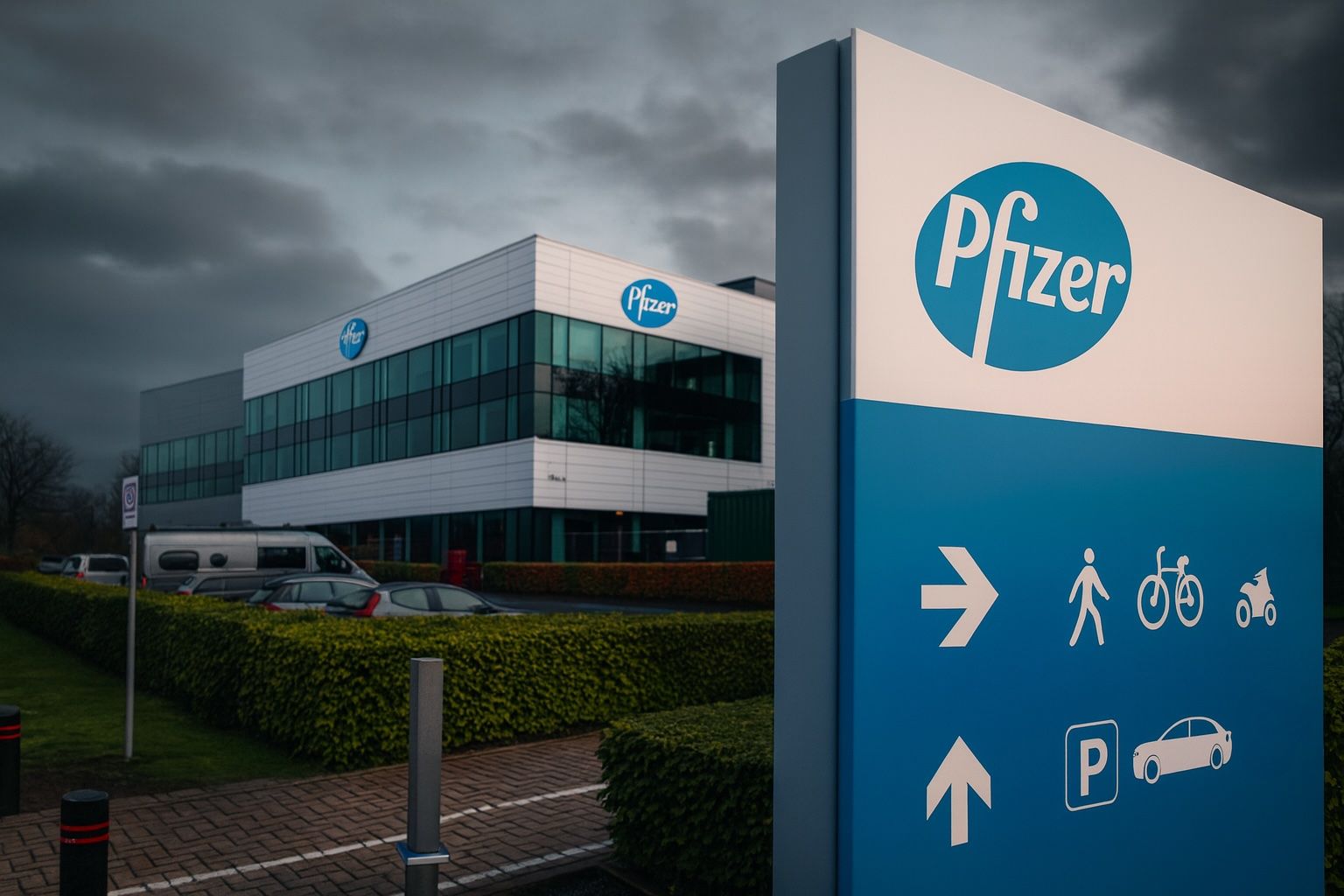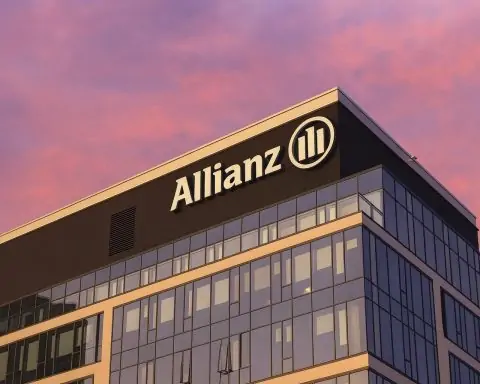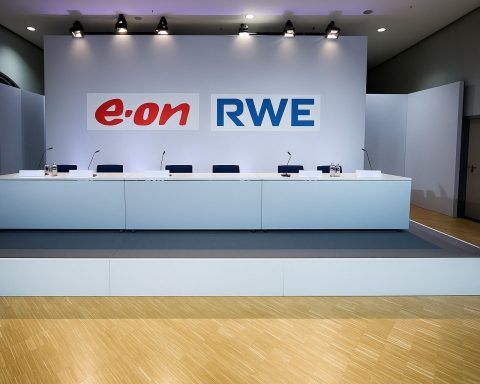- Stock Surge: PFE shares jumped sharply in late September, rising from about $23.6 on Sept 26 to $27.21 on Oct 1 (≈+15% in one week [1]). Notably, the stock climbed ~6.8% on Sept 30 and again on Oct 1 after positive news [2] [3].
- Financials: Pfizer’s market capitalization is on the order of $150 billion (≈$154.7 B as of Oct 2025 [4]). Its trailing price/earnings (P/E) ratio is roughly 14–14.4 [5]– far below its recent peak – and it pays a hefty dividend (yield ≈6% [6]).
- Key News (Sept 28–Oct 1): Pfizer inked a landmark drug-pricing deal with the Trump administration on Sept 30 [7], agreeing to match Medicaid prices to what it charges in other wealthy countries in exchange for tariff relief. The announcement (and Trump’s praise) sent PFE stock sharply higher [8] [9].
- Obesity Pipeline: In September Pfizer also moved aggressively into obesity drugs by agreeing to buy Metsera for about $4.9 billion [10] [11]. Metsera brings a suite of experimental weight-loss therapies (injectable GLP-1 and amylin drugs) that Pfizer hopes will drive late-2020s growth [12] [13].
- Analyst Outlook: Wall Street analysts are largely upbeat. BMO Capital’s Evan Seigerman reiterated a Buy rating (with a $30 price target) and called the Trump deal a “meaningful win” for Pfizer [14] [15]. Jefferies likewise reaffirmed buy, and the consensus price target is about $28.5 (≈12–18% above today’s level) [16] [17].
- Sector Momentum: The broader U.S. drug sector rallied on Pfizer’s news. After months of anxiety over tariffs/“most-favored nation” (MFN) pricing, analysts said this pricing deal removes the worst-case scenario [18] [19]. Shares of peers (Lilly, Merck, AbbVie, BMS, etc.) jumped 2–7% alongside Pfizer [20] [21], and Pfizer’s new agreement is seen as the “beginning of the rebound” for Big Pharma [22] [23].
Share Price & Recent Performance
In early September 2025, Pfizer (NYSE:PFE) was trading in the mid–$20 range. After a relatively quiet first weeks of the month, the stock exploded higher at month-end. On Sept. 30, PFE closed at $25.48 after soaring ~6.8% that day [24]. The rally continued on Oct. 1, with PFE closing at $27.21 (another +6.8%) [25]. In total, Pfizer climbed roughly 15% in the five trading days Sept 26–Oct 1. By contrast, Pfizer had been about flat in August–September, hovering in the low $24s prior to this surge. The late-month gains reflect investor excitement over the Trump pricing deal and positive news on the pipeline.
Over the past month (Sept 1 – Oct 1), PFE is up about 10%. (On Sept 1 it closed around $24.7; on Oct 1 about $27.2 [26].) The 52-week range is approximately $20.9–$30.4 [27], so the stock is near the top of that range after the recent jump. Trading volumes were unusually high on Sept 30 (≈164.9 M shares) and Oct 1 (≈149.1 M) [28], underscoring heavy investor interest. Key catalyst days: Sept 30 (+6.8%) and Oct 1 (+6.8%) correspond to the Trump price-cut announcement and its follow-up [29] [30].
Key Financial Metrics
Pfizer’s market capitalization is roughly $150–155 billion. CompaniesMarketCap.com cites a market cap of $154.70 B as of October 2025 [31] (making Pfizer about the world’s 119th-largest company by cap). End-of-day data on Sept 30 showed roughly $144.8 B [32], so Pfizer has gained due to the recent stock rise. For comparison, peers like Merck and AbbVie are $225 B and $96 B respectively (Pfizer sits in the large-cap pharma group) [33].
On valuations, Pfizer’s P/E ratio is low. According to CompaniesMarketCap, the trailing P/E (TTM) is about 14.4 as of Oct 2025 [34]. This is well below Pfizer’s recent peak (which hit >75 at end-2023 [35]) and below the healthcare sector average (≈24) [36] [37]. The sharp drop from last year’s levels reflects that 2023 had unusually low earnings (reflected in the tiny EPS that quarter). A more recent snapshot (Sept 30) gave a P/E ≈13.5 [38].
Pfizer’s dividend remains one of its highlights. The stock yields roughly 6–7% based on recent prices [39]. CompaniesMarketCap reports a TTM yield of 6.25% [40]. (Pfizer recently trimmed its annual payout from $1.68/share in 2024 to $1.29 in 2025 [41], but even after that cut the yield is very high. Investors see the dividend as robust – the site MarketBeat (not cited) notes ~7.25% on current levels.) For context, an analyst note on Yahoo Finance calls Pfizer a “supercharged dividend stock” with ~7.24% yield [42]. All told, Pfizer offers a high yield but with a cut that highlights a more cautious payout policy.
Other metrics: Price-to-sales is about 2.1 (Morningstar data, though updated values vary) and Pfizer has strong cash flow. The company also has significant R&D spending (announced $70 B over next years as part of the Trump tariff deal [43]). Pfizer’s credit metrics (debt-to-equity, etc.) are not detailed here, but analysts highlight its investment-grade balance sheet.
Sep 28 – Oct 1, 2025 News Highlights
The last days of September brought major news for Pfizer:
- Trump Drug Pricing Deal (Sept 30): On Sept 30, President Trump announced that Pfizer would slash prices of all prescription drugs covered by Medicaid to match the prices charged in other wealthy countries, in exchange for relief from planned pharmaceutical tariffs [44]. Trump said Pfizer “will also offer that most-favored-nation pricing on all new drugs launched in the U.S.” [45]. This announcement was hailed as a breakthrough: Pfizer became the first big pharma to cut such a deal, signaling to investors that broader price-cut mandates could be less disruptive than feared. The stock jumped on the news (Pfizer closed >6% higher that day [46]), and the rally spilled into early Oct. At the White House event, CEO Albert Bourla and even Health Secretary Robert F. Kennedy Jr. were present, underscoring the high-profile nature of the deal.
- Immediate Market Reaction: After the Trump announcement, Pfizer’s stock soared. Shares of Pfizer, along with peers (Eli Lilly, Merck, AbbVie, BMS), were up 2–7% at the Sept 30 close [47]. Analysts said this might be “the beginning of the rebound” for pharmaceuticals [48]. In his commentary, BMO analyst Evan Seigerman noted that MFN pricing and tariffs had been a major concern, but now “today’s announcement appears to read positively” [49]. Gabelli portfolio manager Daniel Barasa added that “with the worst-case scenario now off the table, this development serves as a meaningful clearing event for the sector” [50]. In short, investors saw the deal as removing policy overhangs, causing a broad sector rally.
- Tariffs & TrumpRx Website: The Trump administration had warned of a 100% tariff on imported branded drugs from Oct 1. Under the Pfizer deal, the tariff is waived (for three years) so long as Pfizer shifts more production to the U.S. [51]. Trump also unveiled plans for a direct-to-consumer drug website (dubbed “TrumpRx”) to launch in early 2026, which will list discounted prices for Americans. Pfizer will participate on that platform [52]. These developments signaled that U.S. drug pricing policy is shifting, and Pfizer positioned itself favorably in that landscape.
- Vaccine Pipeline: While not in the immediate Sept 28–Oct 1 window, it’s worth noting that Pfizer and BioNTech have been active on the COVID front. In August, the FDA approved their updated LP.8.1 COVID vaccine for older/high-risk adults [53], and in early September Pfizer announced strong trial data on the 2025–26 vaccine formulation [54]. These moves reinforce Pfizer’s ongoing vaccine business, though they did not drive the late-September stock moves.
- Other Headlines: No other blockbuster news hit between Sept 28–Oct 1 specifically beyond the pricing deal. However, the market had been waiting for Q3 earnings (late October) and was digesting factors like the U.S. government shutdown. (The federal shutdown in early Oct had little direct impact on Pfizer’s news, but broadly markets saw mixed early Oct moves.)
Pipeline and Regulatory Developments
Pfizer’s drug pipeline has been a focus area, especially in obesity and other high-growth categories:
- Obesity/CV Portfolio: In late September, Pfizer took a big swing on obesity drugs by signing a deal to acquire Metsera, a biotech with next-gen weight-loss therapies [55] [56]. The acquisition (announced Sept 22) is valued at $4.9 B upfront, with up to $2.25 B in milestone payments [57] [58]. Metsera’s pipeline includes an injectable GLP-1 agonist (MET-097i) and an oral amylin analog (MET-233i), among others [59] [60]. Pfizer’s R&D head Chris Boshoff says the Metsera portfolio “has the potential to be a key growth driver” in coming years [61]. Analysts at Leerink estimate these drugs could generate about $5 billion in annual sales if successful [62].This deal follows earlier struggles: Pfizer recently abandoned its own late-stage obesity pills (danuglipron and lotiglipron) due to safety/efficacy issues. Buying Metsera lets Pfizer re-enter the weight-loss market with differentiated candidates [63] [64]. The transaction is expected to close in Q4 2025, pending shareholder and regulatory approvals [65].
- Other Pipeline Notes: Pfizer continues work on oncology, inflammation, rare diseases, etc., but no new headline projects emerged in late Sept. Its vaccine pipeline (for COVID-19 and other indications) is progressing: the new COVID vaccine formula (LP.8.1) was already FDA-approved for older adults [66], and Pfizer submitted data on immune response [67]. The company is also developing other next-gen shots.
- Regulatory Affairs: The big regulatory news was the FDA’s approval of the updated COVID-19 shot in August [68] (shipping immediately). No new drug approvals or CRL’s for Pfizer drugs were reported in late Sept. The pricing deal with the White House is partly an indirect regulatory shift: it reflects anticipated changes in U.S. drug policy. Additionally, at the White House event, FDA Commissioner Makary announced a new “Priority Review Voucher” program for breakthrough therapies, but this mostly hinted at future drug review speed-ups; Pfizer did not have a specific voucher news in that window [69].
Partnerships, Acquisitions & Deals
- Metsera Acquisition (Sep 22): As noted, Pfizer agreed to buy Metsera (a NYC-based biopharma) for $4.9 B plus contingents [70] [71]. This strategic move adds 4+ clinical-stage obesity programs to Pfizer’s pipeline in one swoop [72]. Pfizer CEO Albert Bourla said the deal “propels Pfizer into this key therapeutic area” (obesity/cardiometabolic) [73]. It’s one of the company’s largest deals of 2025.
- Government/Policy Deal (Sep 30): The Trump pricing pact itself can be viewed as a strategic partnership with the U.S. government. Pfizer committed to invest $70 billion in U.S. R&D/manufacturing and got a three-year reprieve from tariffs [74]. This is arguably the biggest non-revenue “deal” of the period, with wide strategic impact.
- BioNTech & Vaccines: Pfizer’s longstanding partnership with BioNTech (on mRNA vaccines) continues. In late Sep, Pfizer reported topline data for a new COVID vaccine formula [75], reinforcing that collaboration. They also launched an updated RSV vaccine (Abrysvo) in 2023 with GSK, but no new news in this brief window.
- Other Collaborations: Pfizer has collaborations on therapies (e.g. cancer immunotherapy combos, ALS drugs with Biogen, etc.) but none announced in late Sept. Partnerships in generic drug manufacturing (Pfizer CentreOne) and other alliances (like technology investments) have ongoing activity but no major announcements in the target window.
Analyst Forecasts & Expert Opinions
Analysts were quick to react to the recent news:
- BMO Capital (Evan Seigerman): Seigerman was bullish both on the Trump deal and on Pfizer’s pipeline. He maintained a Buy rating and $30 price target [76] (≈18% above the $25 area at announcement time). He noted that the Medicaid price concessions should be limited in impact to Pfizer’s profits, and the tariff relief is a big plus. Seigerman specifically called the government negotiations “a meaningful win” and flagged Pfizer’s $70B U.S. investment pledge as strategically timed [77].
- Jefferies (Akash Tewari): Jefferies reaffirmed its Buy rating (four-star) on Pfizer, citing the pricing deal as a major positive. One note said Jefferies sees ~33% upside potential. These high targets contrast with the consensus, but illustrate bullish near-term sentiment.
- Other Banks: TD Cowen, while more cautious, also noted the positive effect of the Most-Favored-Nation (MFN) policy being implemented in a way that works for patients, reiterating a $30 target on Pfizer [78]. Goldman Sachs, Credit Suisse and others may have updated models, but as of now no major downgrades have emerged in immediate response.
- Investor Commentary: TipRanks reported that analysts “reaffirmed Buy ratings” on PFE after the pricing agreement [79] [80]. The TipRanks summary noted an average target around $28.5, implying ~12% upside [81]. It mentioned that even Wall Street’s consensus was still a modest Hold overall, but that this latest deal pushed forecasters higher.
- Strategists: A few buy-side portfolio managers (like Gabelli’s Daniel Barasa) publicly commented (via Reuters) that the drug-pricing uncertainty has been resolved, making Pfizer more attractive as a value stock [82] [83]. Those viewpoints have helped lift sentiment on PFE.
In sum, analyst consensus turned more positive in early Oct. While some still caution on margins, the immediate outlook shifted from “MFN worries” to focus on growth via pipeline and buybacks/dividends. Price targets clustered in the upper $20s to $30, reflecting the high yields and any upside from pipeline successes.
Market & Sector Trends
Pfizer’s performance is deeply tied to the broader healthcare sector and market environment:
- Healthcare Stocks Rally: As noted, the entire drug sector jumped after the Trump-Pfizer deal [84]. Before that, investors feared Trump’s threatened tariffs and MFN pricing might seriously dent profits. With those concerns eased, big U.S. pharmas (Lilly, Merck, AbbVie, BMS, GSK among others) all saw gains. Reuters highlighted this as a sector “rebound” [85].
- Macro Factors: The U.S. stock market was also influenced by a federal government shutdown that began Oct 1 (after this report’s date). In general, defensive sectors like healthcare can see interest when uncertainty rises. The shutdown kept markets choppy, but PFE’s moves were driven mainly by pharma-specific news. On Oct 1 the S&P 500 was roughly flat for the day, so Pfizer’s 6-7% rise significantly outperformed the market indices [86].
- Valuation and Rotation: Historically, Pfizer’s P/E had been inflated by COVID-era lows in earnings. Now with earnings normalizing and yields high, many investors see it as an attractively valued “dividend stock” akin to an income play. Its ~6% dividend yield is one of the highest in the S&P 500 [87]. This, combined with an expected rebound in growth (post-COVID, post-MFN), may make PFE appealing if tech and cyclical stocks falter. (TipRanks noted some investors regard it like a safe, high-yielding pharma play).
- Pharma M&A and R&D Trends: Pfizer’s Metsera acquisition echoes a wider trend: Big Pharma is re-stocking pipelines via deals, especially in hot areas like obesity and Alzheimer’s. Analyses of the industry suggest multi-billion deals will continue – e.g., Merck’s pending $36B deal for Seagen was in news; rumors swirl about more tie-ups. The success of Pfizer’s obesity deal could spur competitors to make similar moves (as Reuters noted, Swiss pharma might follow suit [88]).
- Regulatory Environment: Finally, keep an eye on global pharma trends. U.S. policy is shifting (as seen), but drug pricing pressures remain. The EU and Japan are also updating guidelines. For example, Novo Nordisk’s oral Wegovy is under FDA review, which will shape the obesity market [context from pipeline]. Pfizer’s moves seem prescient if U.S. and global payers push to lower prices. Analysts will watch Q3 results (due late Oct) for how these factors actually impact sales and margins.
Summary: As of Oct 1, 2025, Pfizer is in a favorable position: its stock has rallied on a major government deal and bullish pipeline outlook, its valuation is low, and analysts have renewed optimism (with Buys and $30 targets). Key metrics are robust (large market cap, strong dividend), and the company’s strategic moves (pipeline buys, vaccine updates, pricing deals) fit current industry trends. However, investors will monitor how the new pricing terms actually affect revenue and how its obesity drugs perform in trials. For now, the combination of defensive cash flows and growth prospects has made Pfizer a focal point of market attention [89] [90].
Sources: Data and quotes are from Pfizer press releases and financial news agencies (e.g. Reuters, Investing.com), and analyst reports (BMO, TipRanks, etc.) cited above.
References
1. www.investing.com, 2. www.investing.com, 3. www.reuters.com, 4. companiesmarketcap.com, 5. companiesmarketcap.com, 6. companiesmarketcap.com, 7. www.reuters.com, 8. www.reuters.com, 9. www.reuters.com, 10. www.pfizer.com, 11. www.biopharmadive.com, 12. www.pfizer.com, 13. www.biopharmadive.com, 14. www.investing.com, 15. www.tipranks.com, 16. www.tipranks.com, 17. www.investing.com, 18. www.reuters.com, 19. www.reuters.com, 20. www.reuters.com, 21. www.reuters.com, 22. www.reuters.com, 23. www.reuters.com, 24. www.investing.com, 25. www.investing.com, 26. www.investing.com, 27. companiesmarketcap.com, 28. www.investing.com, 29. www.investing.com, 30. www.reuters.com, 31. companiesmarketcap.com, 32. companiesmarketcap.com, 33. companiesmarketcap.com, 34. companiesmarketcap.com, 35. fullratio.com, 36. fullratio.com, 37. companiesmarketcap.com, 38. fullratio.com, 39. companiesmarketcap.com, 40. companiesmarketcap.com, 41. companiesmarketcap.com, 42. finance.yahoo.com, 43. www.reuters.com, 44. www.reuters.com, 45. www.reuters.com, 46. www.reuters.com, 47. www.reuters.com, 48. www.reuters.com, 49. www.reuters.com, 50. www.reuters.com, 51. www.reuters.com, 52. www.reuters.com, 53. www.pfizer.com, 54. www.pfizer.com, 55. www.pfizer.com, 56. www.biopharmadive.com, 57. www.pfizer.com, 58. www.biopharmadive.com, 59. www.pfizer.com, 60. www.biopharmadive.com, 61. www.biopharmadive.com, 62. www.biopharmadive.com, 63. www.biopharmadive.com, 64. www.biopharmadive.com, 65. www.pfizer.com, 66. www.pfizer.com, 67. www.pfizer.com, 68. www.pfizer.com, 69. www.reuters.com, 70. www.pfizer.com, 71. www.biopharmadive.com, 72. www.pfizer.com, 73. www.pfizer.com, 74. www.reuters.com, 75. www.pfizer.com, 76. www.investing.com, 77. www.investing.com, 78. www.investing.com, 79. www.tipranks.com, 80. www.tipranks.com, 81. www.tipranks.com, 82. www.reuters.com, 83. www.reuters.com, 84. www.reuters.com, 85. www.reuters.com, 86. www.investing.com, 87. companiesmarketcap.com, 88. www.investing.com, 89. www.reuters.com, 90. www.investing.com







